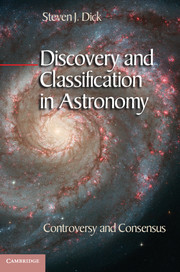Book contents
- Frontmatter
- Contents
- Preface
- Abbreviations
- Introduction The Natural History of the Heavens and the Natural History of Discovery
- Part I Entrée
- Part II Narratives of Discovery
- 2 Moons, Rings, and Asteroids
- 3 In Herschel’s Gardens
- 4 Dwarfs, Giants, and Planets (Again!)
- 5 Galaxies, Quasars, and Clusters
- Part III Patterns of Discovery
- Part IV Drivers of Discovery
- Part V The Synthesis of Discovery
- Appendix 1 Astronomy’s Three Kingdoms
- Appendix 2 Astronomical Discoveries and Their Extended Structure
- Notes
- Select Bibliographical Essay
- Glossary of Concepts Related to Discovery
- Index
4 - Dwarfs, Giants, and Planets (Again!)
The Discovery of the Stars Themselves
from Part II - Narratives of Discovery
Published online by Cambridge University Press: 05 August 2013
- Frontmatter
- Contents
- Preface
- Abbreviations
- Introduction The Natural History of the Heavens and the Natural History of Discovery
- Part I Entrée
- Part II Narratives of Discovery
- 2 Moons, Rings, and Asteroids
- 3 In Herschel’s Gardens
- 4 Dwarfs, Giants, and Planets (Again!)
- 5 Galaxies, Quasars, and Clusters
- Part III Patterns of Discovery
- Part IV Drivers of Discovery
- Part V The Synthesis of Discovery
- Appendix 1 Astronomy’s Three Kingdoms
- Appendix 2 Astronomical Discoveries and Their Extended Structure
- Notes
- Select Bibliographical Essay
- Glossary of Concepts Related to Discovery
- Index
Summary
It is hardly exaggerated to say that the spectral classification now adopted is of similar value as a botany, which divide the flowers according to their size and color. To neglect the c-properties in classifying stellar spectra is nearly the same thing as if the zoologist, who has detected the deciding differences between a whale and a fish, would continue in classifying them together.
Ejnar Hertzsprung, 1908There seem, therefore to be two series of stars, one very bright and of almost the same brightness, whatever the spectrum, the other diminishing rapidly in brightness with increasing redness ... These series were first noticed by Dr. Hertzsprung, of Potsdam, and called by him “giant” and “dwarf” stars.
Henry Norris Russell, 1913The message of the Companion of Sirius, when decoded, ran: “I am composed of material 3,000 times denser than anything you have come across; a ton of my material would be a little nugget you could put in a matchbox.” What reply can one make to such a message? The reply which most of us made in 1914 was – “Shut up. Don’t talk nonsense.”
Arthur S. Eddington, 1927As historian David DeVorkin has written, by the early twentieth century, American astrophysicists were becoming world leaders in astronomical natural history thanks to the unparalleled power of astrophysics to reveal the nature of celestial bodies. “Akin to the naturalist, the typical American professional astronomer was collector and classifier. Instead of museum shelves and cases, astronomers stored their systematic observations in plate vaults and letterpress log books, and displayed them in catalogues sponsored by universities and observatories.” In particular, as more and more stellar spectra were gathered, they hinted at numerous variations in the nature of the stars. Once stellar physics was understood later in the twentieth century the reasons became clear: stellar structure depended on mass, temperature, and luminosity, and the range of all of these physical variables was enormous. Moreover, stars existed in a variety of different ages, and (it turned out) in a variety of stages. Stars were born, lived, and died; once the concept of stellar evolution was accepted, the problem was determining which stars were in which stages and how the physics worked under varying conditions, among the greatest puzzles in the history of science. In short, William Herschel’s gardens, first explored with his work on the nebulae, were luxuriant beyond his wildest dreams when it came to the stars themselves.
- Type
- Chapter
- Information
- Discovery and Classification in AstronomyControversy and Consensus, pp. 91 - 120Publisher: Cambridge University PressPrint publication year: 2013



